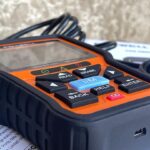Modern cars are complex systems, constantly monitoring a wealth of data. For car enthusiasts and those keen on vehicle diagnostics, tapping into this data stream can unlock valuable insights. One common desire is to monitor engine coolant temperature, a critical indicator of engine health. While some older vehicles had dedicated gauges, many newer models omit them, relying instead on warning lights that often activate too late. This is where the power of Can Bus Obd2 Arduino projects comes into play.
This article explores how you can use an Arduino, coupled with a CAN Bus shield, to access your car’s On-Board Diagnostics (OBD2) system and specifically extract the engine coolant temperature. This DIY approach offers a customizable and potentially more informative solution than generic OBD2 ‘HUD’ displays, which may lack support for all vehicle models.
Let’s delve into the key questions you might have when embarking on this project:
Choosing the Right Arduino and CAN Bus Shield
For a dedicated coolant temperature display, a compact Arduino board is ideal. Options like the Arduino Nano or Arduino Pro Mini are excellent choices due to their small size and sufficient processing power. When it comes to CAN Bus shields, several reputable options are available. Look for shields that are well-documented and have readily available libraries. Shields based on controllers like the MCP2515 are commonly used and supported within the Arduino ecosystem. Consider the physical size and mounting requirements of both the Arduino and shield to ensure a neat and integrated solution within your vehicle.
Navigating CAN Bus Libraries for Arduino
Fortunately, you don’t need to start from scratch when it comes to CAN Bus communication with Arduino. Several robust and user-friendly CAN Bus libraries are available. Many CAN Bus shield manufacturers provide their own libraries, which are often a good starting point as they are tailored to their specific hardware. Beyond manufacturer-specific libraries, community-developed libraries like arduino-canbus-lib are popular and well-maintained, offering broad compatibility and features for decoding CAN Bus data. Exploring examples within these libraries will be crucial for understanding how to initialize the CAN Bus shield, receive messages, and filter for relevant data.
Understanding CAN Bus and OBD2 for Coolant Temperature
The real challenge lies in deciphering the raw CAN Bus data to pinpoint the engine coolant temperature. OBD2 standards define a set of Parameter IDs (PIDs) for accessing standardized diagnostic information. Engine coolant temperature is typically available as a standard OBD2 PID. However, the data is transmitted over the CAN Bus in a specific format.
To extract the coolant temperature, you’ll need to:
- Identify the Correct PID: Research the OBD2 PID for coolant temperature. A common PID is
05(Coolant Temperature). - Understand CAN Bus Message Structure: CAN Bus messages have an ID, data bytes, and other control bits. OBD2 PIDs are usually transmitted within specific CAN message IDs.
- Decode the Data Bytes: The coolant temperature value is encoded within the data bytes of the CAN message. You’ll need to consult OBD2 documentation or online resources to understand the encoding formula. Typically, it involves converting the relevant data byte(s) into a temperature value using a specific scaling factor and offset.
Online resources, automotive forums, and OBD2 documentation are invaluable for finding the specific CAN message IDs and data encoding methods used by your vehicle’s manufacturer. Websites and databases dedicated to OBD2 PIDs and CAN Bus reverse engineering can significantly speed up this process.
Conclusion: Empowering Your Car Diagnostics
By combining an Arduino, a CAN Bus shield, and freely available libraries, you can create a custom coolant temperature display and gain deeper insights into your vehicle’s operation. This project not only addresses the lack of temperature gauges in modern cars but also opens the door to exploring other OBD2 parameters and developing more sophisticated DIY car diagnostic tools. While it requires some technical investigation into CAN Bus and OBD2 protocols, the rewards are a greater understanding of your car’s health and the satisfaction of a successful DIY automotive project.

